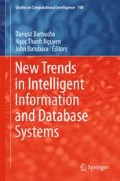Abstract
The article discusses the design of appropriate methodology of segmentation and visualization of MRI data to extract the blood vessels. The main objective of the proposed algorithm is effective separation individual vessels and adjecent structures. In clinical practice, it is necessary to assess the progress of the blood vessels in order to assess the condition of the vascular system. For physician who performs diagnosis is much more rewarding to perform analysis of an image that contains only vascular elements. The proposed method of image segmentation can effectively separate the individual blood vessels from surrounding tissue structures. The output of this analysis is the color coding of the input image data to distinguish contrasting behavior of individual vessels that are at the forefront of our concerns, the structures that we need in the picture.
Access this chapter
Tax calculation will be finalised at checkout
Purchases are for personal use only
Preview
Unable to display preview. Download preview PDF.
References
Otsu, N.: A threshold selection method from gray-scale histogram. IEEE Trans. on Sys., Man and Cyb. 9(1), 62–66 (1979)
Szczepaniak, P., Kacprzyk, J.: Fuzzy systems in medicine. Physica-Verlag, New York (2000)
Ville, D.V.D., Nachtegael, M., Der Weken, D.V., Kerre, E.E., Philips, W., Lemahieu, I.: Noisereduction by fuzzy image filtering. IEEE Trans. Fuzzy Sys. 11(4) (2003)
Fernández, S., et al.: Soft tresholding for medical image segmentation. IEEE EMBS (2010)
Bezdek, J.C., Pal, S.K.: Fuzzy Models for Pattern Recognition. IEEE Press, New York (1992)
Falcao, A.X., Udupa, J.K., Samarasekera, S., Sharma, S.: User-steered image segmen-tation paradigms: live wire and live lane. Graphical Models Image Process 60, 233–260 (1998)
Eckstein, F., Tieschky, M., Faber, S., Englmeier, K.H., Reiser, M.: Functional analysis of articular cartilage deformation, recovery, and fluid flow following dynamic exercise in vivo, pp. 419–424. Anat Embryol, Berl (1999)
McWalter, E.J., Wirth, W., Siebert, M., Eisenhart-Rothe, R.M., Hudelmaier, M., Wilson, D.R., et al.: Use of novel interactive input devices for segmentation of articular cartilage from magnetic resonance images, Osteoarthritis Cartilage, pp. 48–53 (2005)
Graichen, H., Al Shamari, D., Hinterwimmer, S., Eisenhart-Rothe, R., Vogl, T., Eckstein, F.: Accuracy of quantitative magnetic resonance imaging in the detection of ex vivo focal cartilage defects, Ann Rheum Dis, pp. 1120–1125 (2005)
Schmid, M., Conforto, S., Camomilla, V., Cappozzo, A., Alessio, T.D.: The sensitivity of posturographic parameters to acquisition settings. Medical Engineering & Physics 24(9), 623–631 (2002)
Severini, G., Conforto, S., Schmid, M., Alessio, T.: D’: Novel formulation of a double threshold algorithm for the estimation of muscle activation intervals designed for variable SNR environments. Journal of Electromyography and Kinesiology 22(6), 878–885 (2012)
Author information
Authors and Affiliations
Corresponding author
Editor information
Editors and Affiliations
Rights and permissions
Copyright information
© 2015 Springer International Publishing Switzerland
About this paper
Cite this paper
Kubicek, J., Penhaker, M., Pavelova, K., Selamat, A., Hudak, R., Majernik, J. (2015). Segmentation of MRI Data to Extract the Blood Vessels Based on Fuzzy Thresholding. In: Barbucha, D., Nguyen, N., Batubara, J. (eds) New Trends in Intelligent Information and Database Systems. Studies in Computational Intelligence, vol 598. Springer, Cham. https://doi.org/10.1007/978-3-319-16211-9_5
Download citation
DOI: https://doi.org/10.1007/978-3-319-16211-9_5
Publisher Name: Springer, Cham
Print ISBN: 978-3-319-16210-2
Online ISBN: 978-3-319-16211-9
eBook Packages: EngineeringEngineering (R0)

